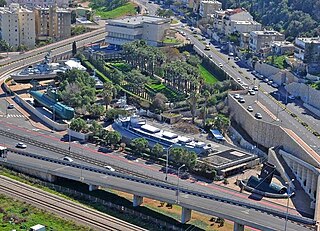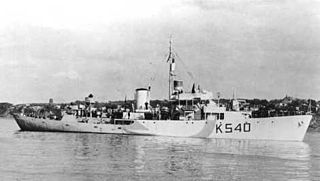
Landing craft are small and medium seagoing watercraft, such as boats and barges, used to convey a landing force from the sea to the shore during an amphibious assault. The term excludes landing ships, which are larger. Production of landing craft peaked during World War II, with a significant number of different designs produced in large quantities by the United Kingdom and United States.

The landing craft, tank (LCT) was an amphibious assault craft for landing tanks on beachheads. They were initially developed by the Royal Navy and later by the United States Navy during World War II in a series of versions. Initially known as the "tank landing craft" (TLC) by the British, they later adopted the U.S. nomenclature "landing craft, tank" (LCT). The United States continued to build LCTs post-war, and used them under different designations in the Korean and Vietnam Wars.

Landing Ship, Tank (LST), or tank landing ship, is the naval designation for ships first developed during World War II (1939–1945) to support amphibious operations by carrying tanks, vehicles, cargo, and landing troops directly onto a low slope beach with no docks or piers. The shallow draft and bow doors and ramps enabled amphibious assaults on almost any beach.
Aliyah Bet was the code name given to illegal immigration by Jews, most of whom were refugees escaping from Nazi Germany, and later Holocaust survivors, to Mandatory Palestine between 1920 and 1948, in violation of the restrictions laid out in the British White Paper of 1939, which dramatically increased between 1939 and 1948. With the establishment of the State of Israel in May 1948, Jewish displaced persons and refugees from Europe began streaming into the new state in the midst of the 1948 Palestine war.

USS Benzie County (LST-266) was an LST-1-class tank landing ship built for the United States Navy during World War II. Named for Benzie County, Michigan, she was the only U.S. Naval vessel to bear the name.
USS LST-453 was a United States Navy LST-1-class tank landing ship used in the Asiatic-Pacific Theater during World War II. She was converted at Brisbane, Australia, into an Achelous-class repair ship, shortly after commissioning, and used in the repairing of landing craft. She was later renamed for Remus, she was the only US Naval vessel to bear the name.

Shmuel "Samek" Yanai was a former Israeli naval commander and chair of the Atlit Museum of Illegal Immigration at the Atlit detainee camp.
USS LST-141 was an LST-1-class tank landing ship built for the United States Navy in World War II. Like most of the ships of her class, she was not named and known only by her designation.

The Mark 8 Landing Craft Tank were landing craft tank ships operated by the British Armed Forces. The vessels were based on an American design, but improved into ocean-going vessels capable of sailing to and operating in the Far East.

USS Oak Hill (LSD-7) was an Ashland-class dock landing ship of the United States Navy, named in honor of Oak Hill, the Virginia estate of President James Monroe (1758–1831).

An amphibious warfare ship is an amphibious vehicle warship employed to land and support ground forces, such as marines, on enemy territory during an amphibious assault.
USS LST-371 was a LST-1-class tank landing ship used by the United States Navy.

The Casa Grande class was a class of dock landing ships used by the Royal Navy and the United States Navy during the Second World War. Nineteen ships were planned, but two, USS Fort Snelling and USS Point Defiance were cancelled before being completed.

HMS Mendip (L60) was a Hunt-class destroyer of the Royal Navy. She was a member of the first subgroup of the class. The ship is notable for seeing service in the navies of three other nations after her use by the Royal Navy. She saw service in the Second World War and later as an Egyptian Navy ship in the Suez Crisis. She was captured in battle on 31 October 1956 by the Israeli Navy and re-commissioned as INS Haifa (K-38).

The Clandestine Immigration and Naval Museum is a technical history museum located in Haifa, Israel.

HMS Versatile (D32) was an Admiralty V-class destroyer of the British Royal Navy that saw service in World War I, the Russian Civil War, and World War II.

HMCS Beauharnois was a modified Flower-class corvette that served with the Royal Canadian Navy during the Second World War, primarily in the Battle of the Atlantic. After the war it was sold to a Jewish resettlement movement and eventually made its way into the nascent Israeli Navy.

HM LCT 7074 is the last surviving Landing Craft, Tank (LCT) in the UK. LCT 7074 is an amphibious assault ship for landing tanks, other vehicles and troops on beachheads. Built in 1944 by Hawthorn Leslie and Company, Hebburn, the Mark 3 LCT 7074 was part of the 17th LCT Flotilla during Operation Neptune in June 1944.
HMIS Ahmedabad was a Basset-class trawler that was part of the Royal Indian Navy. The ship was laid down in Bombay by Scindia Steam Navigation Co Ltd in 1941 and was launched in 1943. She was under the command of Lieutenant Robert Love of the Royal Indian Naval Reserve from the 14th April 1944 until early 1945, when he was replaced by Lieutenant Hosi Behramji Dubash of the Royal Indian Naval Volunteer Reserve Ahmedabad was an anti-submarine trawler. One of the journeys that the ship made was during a cyclone in 1945 on the Indian east coast from Visakhapatnam to search for a landing craft tank (LCT) but in Coconda, Ahmedabad grounded and had to be salvaged.



















